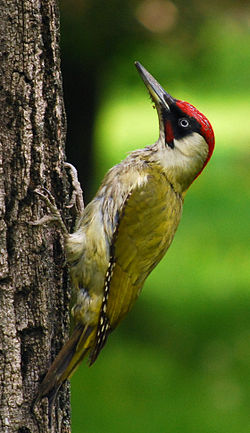European green woodpecker
The European green woodpecker (Picus viridis), or European green woodpecker, is a member of the woodpecker family Picidae. It occurs in most of Europe and in western Asia. There are four subspecies. All have green upperparts, paler yellowish underparts, and a red crown.
| European green woodpecker | |
|---|---|

| |
| European green woodpecker (male) | |
| Scientific classification | |
| Domain: | Eukaryota |
| Kingdom: | Animalia |
| Phylum: | Chordata |
| Class: | Aves |
| Order: | Piciformes |
| Family: | Picidae |
| Genus: | Picus |
| Species: | P. viridis
|
| Binomial name | |
| Picus viridis | |

| |
| Range | |
| Synonyms | |
|
Gecinus viridis[2] | |
The woodpecker spends much of its time feeding on ants on the ground and does not often 'drum' on trees like other woodpecker species. It is a shy bird but usually draws attention with its loud calls. A nest hole is excavated in a tree; four to six eggs are laid which hatch after 19–20 days.
It gives a loud call known as yaffling.
Old deciduous trees for nesting, and nearby feeding grounds with plenty of ants, is essential. This is usually found in semi-open landscapes with small woodlands, hedges, scattered old trees, edges of forests and floodplain forests. Suitable habitats for foraging include grassland, heaths, plantations, orchards and lawns.[3]
References
change- ↑ BirdLife International (2013). "Picus viridis". IUCN Red List of Threatened Species. 2013. Retrieved 26 November 2013.
- ↑ John Gould describes the green woodpecker, Gecinus viridis in The Birds of Great Britain (vol. 3, 1873, plate 74).
- ↑ Alder D. & Marsden S. 2010. Characteristics of feeding‐site selection by breeding green woodpeckers Picus viridis in a UK agricultural landscape. Bird study, 57(1), 100-107.
